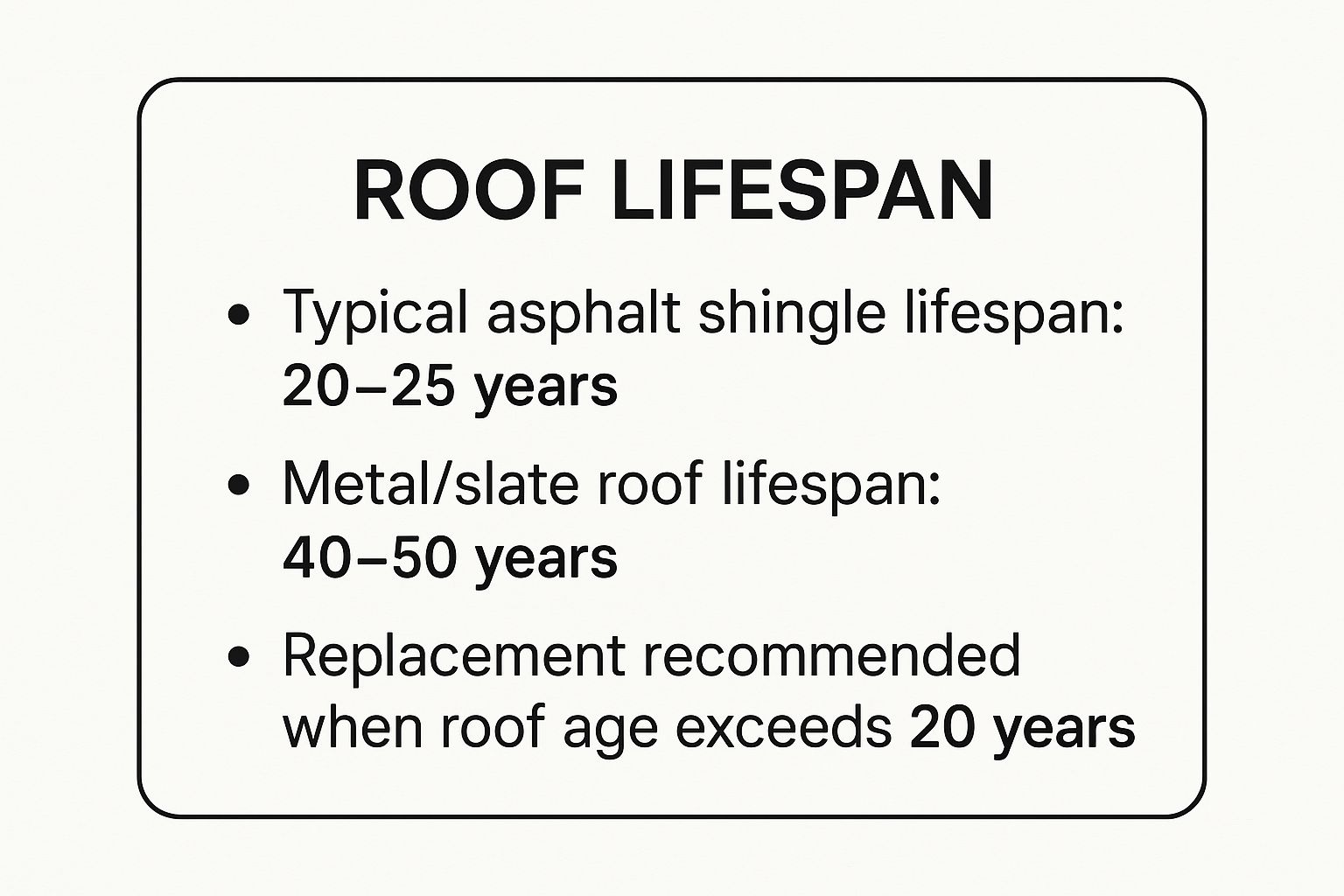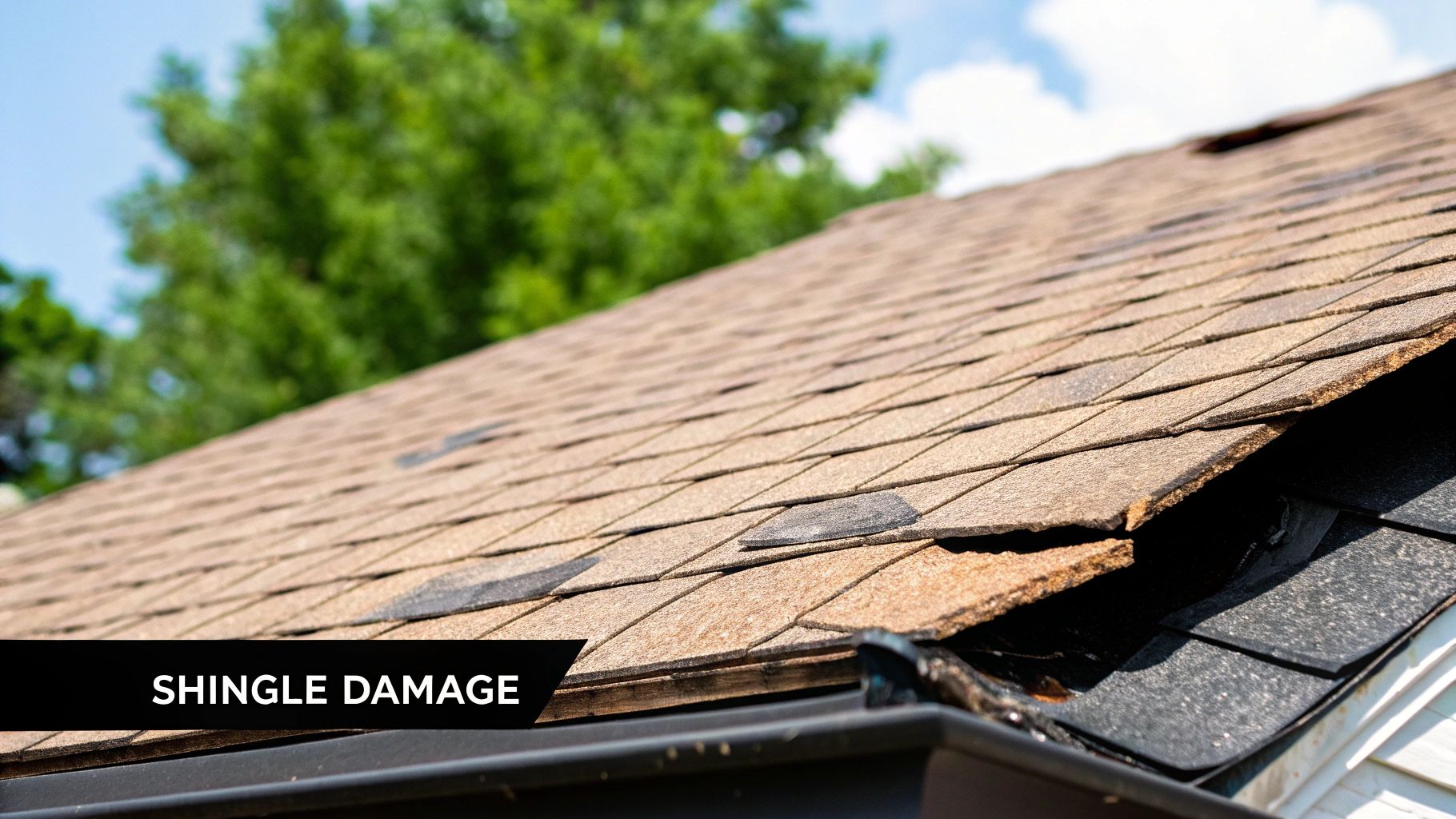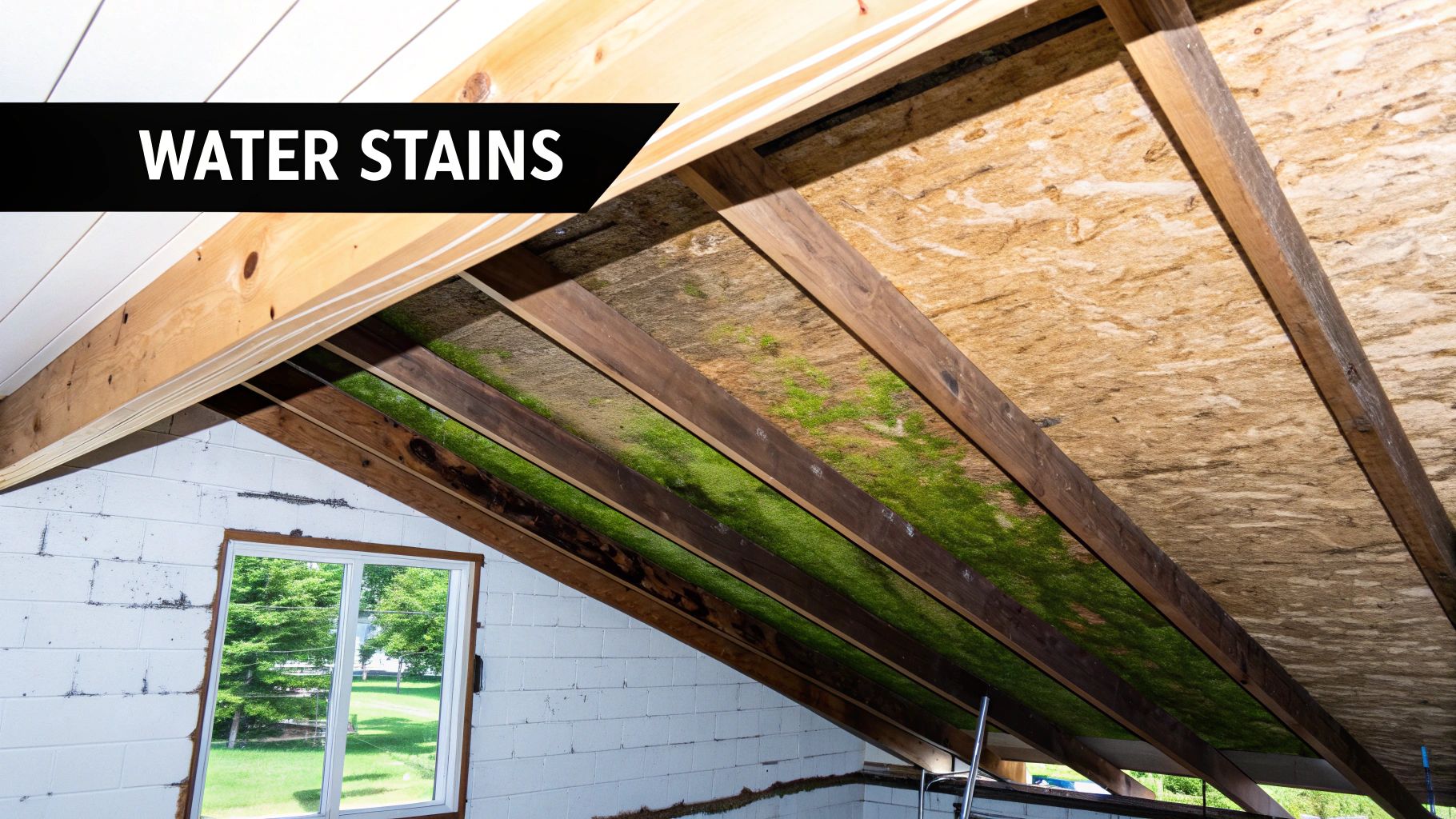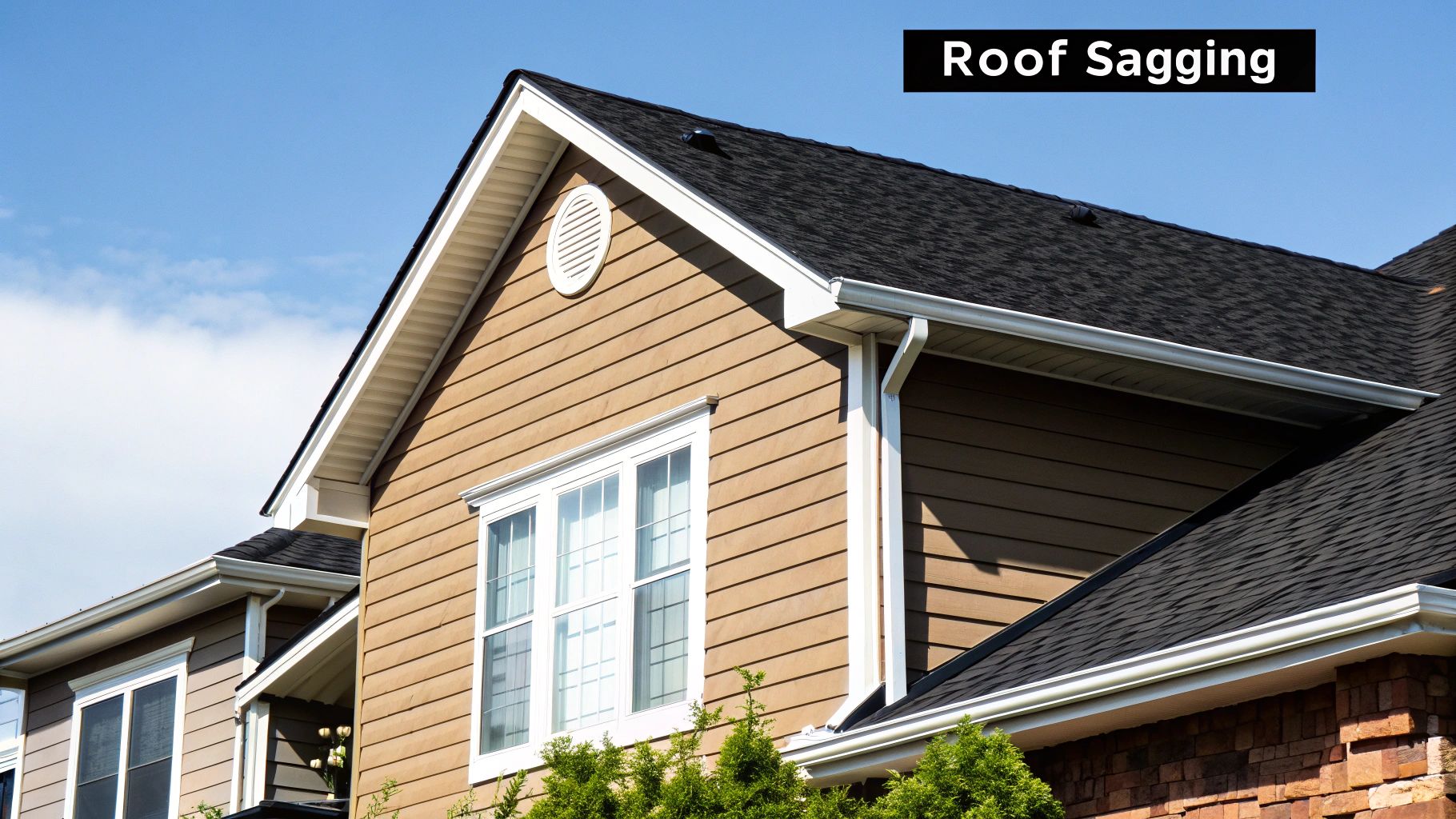Deciding to replace your roof comes down to three actionable checks: evaluating its age against local climate conditions, performing a visual inspection from the ground for specific warning signs, and checking your gutters for evidence of decay. If your asphalt shingle roof is over 20 years old and shows signs of curling, cracking, or significant granule loss, it's time to start planning for a replacement before minor issues escalate into major damage.
Your Guide to Critical Roof Warning Signs
Many homeowners only address their roof after a leak appears in the ceiling. This is a costly mistake. By the time water damage is visible inside, the underlying rot and structural issues are often extensive and expensive to fix.
The key is to proactively identify problems. Learning to spot the early warning signs allows you to schedule a repair or replacement on your terms, not in an emergency.
Start with the most straightforward factor: your roof’s age. An average asphalt shingle roof, found on roughly 75% of U.S. homes, is designed to last 15 to 30 years. However, this lifespan can be significantly shortened by factors like shingle quality and intense local weather, such as the sun and storms common in South Florida. For context on how material choice impacts longevity, you can explore data on roofing market trends.
Visual Clues You Can Spot From The Ground
You don't need to climb a ladder to assess your roof's condition. A careful walk around your property can provide the actionable intelligence you need.
Here is a checklist of what to look for:
- Curling or "Clawing" Shingles: Look for shingle edges that are turning upward or tabs that are lifting in the middle. This indicates the shingles have aged, lost flexibility, and are no longer sealing properly.
- Cracked or Missing Shingles: Scan for obvious gaps where shingles have blown off or visible cracks across shingle surfaces. Each gap is a direct entry point for water. While a few missing shingles might be a simple repair, widespread cracking indicates the entire roof system is brittle.
- Dark Streaks or Moss: Note any dark, algae-like streaks. While sometimes cosmetic, algae retains moisture against the shingle surface, accelerating wear and signaling potential moisture problems.
Actionable Tip: Don't dismiss a few curled shingles. They are often the first indicator of systemic failure. Treat them as a clear sign that the entire roof is aging and becoming vulnerable, prompting the need for a professional inspection.
To help you understand what to expect from different materials, use this quick reference guide.

As shown, a standard asphalt shingle roof often requires replacement around the 20-year mark. In contrast, more durable materials like metal can last twice as long, a key consideration for your next investment.
To make your assessment even clearer, use this table to connect visible problems with necessary actions.
Common Roof Problems and Recommended Actions
This table outlines frequent issues and the appropriate response, helping you decide whether to schedule an inspection, a repair, or a full replacement.
| Warning Sign | What It Looks Like | Action Required |
|---|---|---|
| Curling Shingles | Edges of shingles are turning upward or tabs are lifted. | Plan for Replacement. This signals advanced age and systemic failure. |
| Missing Shingles | Obvious gaps where shingles have blown off. | Schedule a Repair if it's a small, isolated area. Plan for Replacement if widespread. |
| Cracked Shingles | Random cracks appearing across multiple shingles. | Plan for Replacement. Widespread cracking means the material is brittle and failing. |
| Granule Loss | Bald spots on shingles; sand-like granules in gutters. | Plan for Replacement. The protective UV layer is gone. |
| Dark Streaks | Black or green streaks, often caused by algae. | Schedule an Inspection. May need professional cleaning, but signals underlying moisture issues. |
| Sagging Roof | A visible dip, droop, or curve in the roofline. | Call a Professional for IMMEDIATE INSPECTION. This indicates a serious structural problem. |
By actively looking for these signs, you can address small issues before they become catastrophic failures.
Conducting a Safe Ground-Level Roof Check

You can effectively diagnose your roof's health without leaving the ground. A methodical ground-level check is the safest and most effective first step in identifying potential problems.
Your Action Plan:
- Get Binoculars: Use a pair of binoculars to get a detailed view from a safe distance, like your yard or across the street.
- Scan the Entire Roof: Methodically scan every section of the roof. Look for the most common red flags: shingles that are curling, buckling, cracked, or missing. These are clear signs that the shingles are at the end of their service life.
Inspecting Key Trouble Spots
Focus your inspection on the areas most prone to leaks. These "penetrations" where something passes through the roof are the most common points of failure.
Use your binoculars to zoom in on these specific zones:
- Flashing: Check the metal strips around chimneys, vents, and skylights. Look for rust, cracks, or any sections that are pulling away from the roof. Damaged flashing is a primary cause of leaks.
- The Ridgeline: Examine the peak of your roof. It should be perfectly straight. If you see any sagging or dipping, it's a major red flag for underlying structural issues with the roof decking.
- Valleys: Inspect the channels where two roof planes meet. Debris accumulates here, trapping moisture and causing the shingles in the valley to rot much faster than on the rest of the roof.
Actionable Tip: Perform your visual check right after it rains. Any dark patches that remain wet long after the rest of the roof has dried indicate that shingles are saturated and no longer shedding water effectively. This is a sign of granule loss and old age.
Checking Your Gutters for Clues
Your gutters provide direct evidence of your roof's health. Your action item is simple: after the next rain, inspect the contents of your downspouts and gutters.
If you find a significant accumulation of coarse, black, sand-like granules, your roof has a serious problem. These granules are the protective layer that shields your shingles from UV rays. When they wash away, the shingles are exposed and will rapidly deteriorate. A few granules are normal, but if you can scoop up a handful, your roof's protective layer is gone and replacement is imminent.
For a high-resolution analysis, consider using modern drone roofing inspection software. This technology provides a safe and detailed assessment, making it easier to document issues when you call a professional.
Finding Roof Problems From Inside Your Home

Some of the most critical evidence of a failing roof is found inside your home. An interior inspection, especially in your attic, can reveal problems long before they are visible from the outside.
Your Action Plan: On a bright, sunny day, go into your attic. Turn off all the lights and let your eyes adjust to the darkness.
Your goal is to look for daylight. If you can see any beams or pinpricks of light coming through the roof boards, you have direct holes to the outside. This signifies a complete failure of the shingles, underlayment, and decking, and requires immediate professional attention before the next rainfall.
Tracking Down Hidden Water Damage
Water rarely announces itself with an obvious drip. It typically leaves subtle clues. Use a flashlight to inspect the underside of your roof deck (the plywood or OSB sheathing).
Here is your checklist for hidden water damage:
- Dark Stains or Streaks: Look for dark marks on the wood, which indicate where water has seeped in and run down the decking.
- Sagging Decking: Press gently on the roof sheathing between the rafters. If it feels soft, spongy, or looks bowed, it's a clear sign of long-term water saturation and rot.
- Signs of Mold or Mildew: Note any musty odors or visible mold growth. This confirms an active, long-term leak and poses a health risk.
These interior clues are essential for diagnosing how to know when a roof needs replacing. A small stain might indicate a minor repair, but widespread staining or sagging decking confirms a systemic failure that requires a full replacement.
Pro Insight: I once inspected an attic for a homeowner who was certain there were no leaks. The underside of the roof deck was covered in black streaks. The roof was rotting from the inside out, and a full replacement was the only viable solution.
The Critical Role of Attic Ventilation
Your attic inspection should also include a ventilation check. A poorly ventilated attic traps heat and moisture, which drastically shortens your roof's lifespan.
In summer, a trapped-heat attic can exceed 150°F, baking your shingles from below and making them brittle. In winter, trapped moisture condenses on the cold decking, causing rot and mold.
Action Item: Check that your soffit (eave) vents and ridge vents are clear of insulation, debris, or paint. Proper airflow is non-negotiable for roof longevity. If your attic feels intensely hot and stuffy, your ventilation is inadequate and is accelerating the need for a roof replacement.
How Age and Climate Impact Your Roof
A roof's lifespan is determined by its age, its materials, and the climate it endures. To accurately determine how to know when a roof needs replacing, you must understand how these factors work together.
A roof's warranty is a best-case scenario, not a guarantee. An asphalt shingle roof rated for 25 years might fail at year 15 in a harsh climate like South Florida, while the same roof in a milder region could exceed its warranty period.
The Impact of Regional Weather
Your local environment is your roof's biggest adversary. Constant exposure to extreme weather accelerates deterioration, forcing homeowners in harsh climates to replace their roofs more frequently.
In Florida, roofs face a multi-front battle:
- Intense Sun and UV Rays: The sun bakes the oils out of asphalt shingles, causing them to become brittle and crack. It also degrades the protective granule layer, leading to premature failure.
- High Winds and Hurricanes: Strong winds lift shingles, breaking their watertight seals. Once a seal is broken, it creates an entry point for wind-driven rain.
- Heavy Rain and Humidity: Constant moisture promotes the growth of algae and moss, which trap water against the roof surface and accelerate rot.
Actionable Tip: Judge your roof based on its condition and local climate, not just its age. A 10-year-old roof in a storm-prone area is often in worse shape than a 20-year-old roof in a mild climate. Your local weather is the most reliable predictor of its true lifespan.
Matching Materials to the Environment
Choosing the right roofing material for your climate is a critical decision. Some materials are engineered for harsh conditions, while others are not.
For example, a standard 3-tab asphalt shingle is the most economical option but offers the shortest lifespan, often failing around 15-20 years in a high-heat, high-wind climate.
Investing more upfront in a climate-appropriate material can provide significantly better long-term value:
- Architectural Shingles: Thicker and heavier than 3-tab shingles, they offer superior wind resistance and a realistic lifespan of 25-30 years.
- Metal Roofing: An excellent choice for coastal regions, metal roofs can withstand extreme weather and last 40-70 years, making them a smart long-term investment.
- Tile (Clay or Concrete): Extremely durable and resistant to sun and heat, tile roofs can last 50+ years. However, they are very heavy and require a home structure engineered to support the weight.
By evaluating both your roof's age and the specific weather challenges it faces, you can make an informed and realistic decision about when a replacement is necessary.
Deciding Between Roof Repair and Replacement

Once you've identified a roof problem, you must decide on the correct course of action: repair or replace. This financial decision requires a careful assessment of the situation to avoid wasting money on short-term fixes for a long-term problem.
A repair is the right choice for a younger roof with isolated, contained damage. For example, if a storm blew off a few shingles but the rest of the roof is in good condition with years of life left, a targeted repair is the most logical and cost-effective solution.
However, once problems become widespread, the decision-making criteria change. This is the crucial point where you must understand how to know when a roof needs replacing instead of another patch.
When Replacement Becomes The Only Smart Move
Fixing one leak is a repair. Fixing three leaks in different areas is a sign of systemic failure. Continuously patching an old, failing roof is a poor financial strategy that ignores the underlying cause.
These are clear indicators that a full replacement is the most sensible investment:
- You're Chasing Leaks: If you fix one leak only for another to appear elsewhere, the underlayment has likely failed across the roof.
- Widespread Granule Loss: If you see numerous "bald" spots on your shingles, their UV protection is gone. This cannot be repaired.
- Advanced Age: If your asphalt shingle roof is over 20 years old, any money spent on repairs is delaying an inevitable—and likely more expensive—replacement.
Actionable Rule of Thumb: Use the "50% Rule." If repair costs exceed 50% of the cost of a new roof, or if more than 50% of the roof is damaged, replacement is the better financial decision.
Looking Beyond The Immediate Damage
The decision to replace isn't always about damage; it can be about long-term value. The global roofing market, valued at $267.64 billion in 2023, is increasingly focused on energy efficiency and sustainability. A new roof can be a strategic upgrade. This principle of upgrading for long-term value is common in home maintenance, as seen in the long-term benefits of maintaining and restoring parts of your home.
A new, modern roof can significantly lower your energy bills by reflecting more solar radiation and may even increase your home's resale value, making it a smart financial upgrade, not just a necessary expense.
Common Questions About Roof Replacement
A roof replacement is a major project, and most homeowners have similar questions. Getting clear answers helps you budget, plan, and feel confident in your decision.
How Much Does a New Roof Cost?
The cost of a new roof depends on its size, pitch (steepness), the material you choose, and local labor rates. Asphalt shingles are the most budget-friendly option, while materials like metal or tile have a higher upfront cost but offer a much longer lifespan, often resulting in a lower lifetime cost.
Action Plan: Always get a minimum of three detailed, written quotes from licensed and insured roofing contractors. Ensure each quote itemizes all costs, including materials, labor, tear-off of the old roof, and debris disposal.
Can I Install New Shingles Over Old Ones?
No. This practice, known as a "roof-over" or "layover," is a risky shortcut that should always be avoided. It adds excessive weight to your home's structure, traps moisture between the layers, and prevents the roofer from inspecting and repairing the underlying wood decking for rot or damage.
A complete tear-off of the old roofing material is non-negotiable for a professional, long-lasting installation. Most local building codes prohibit more than two layers of shingles anyway. Insist on a full tear-off.
How Long Does a Replacement Project Take?
A professional crew can typically replace the roof on an average-sized single-family home in one to three days.
Factors that can extend this timeline include:
- Weather: Rain or high winds will pause work for safety reasons.
- Roof Complexity: Steep roofs or those with many skylights and vents require more time.
- Hidden Damage: If the crew discovers rotted decking after the tear-off, it must be replaced, which adds time to the project but is critical for a sound installation.
Your contractor should provide a clear, realistic project schedule before work begins.
Will My Insurance Cover a New Roof?
Homeowners' insurance typically covers roof replacement only if the damage resulted from a sudden, specific event (an "act of God"), such as a hurricane, tornado, major hail storm, or a fallen tree. Insurance does not cover replacement for a roof that has failed due to old age, wear and tear, or lack of maintenance.
Action Plan: If you believe a storm caused the damage, your first step is to document everything with photos and videos. Then, contact your insurance agent to review your policy and begin the claims process.
When you're ready for a clear, honest assessment and a high-quality roof replacement, trust the experts at Exact Roofing. We are dedicated to providing durable, reliable roofing solutions for homeowners across South Florida. Contact us today for a detailed estimate at https://www.exactcontractors.com.

